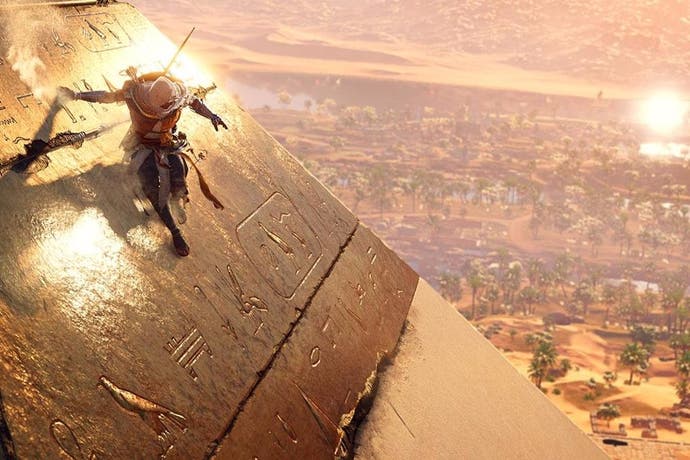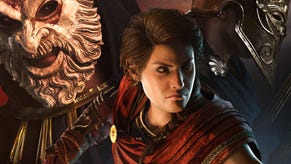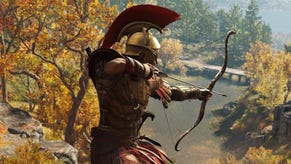Assassin's Creed Origins makes the series' past stumbles feel like ancient history
Tomb with a view.
Assassin's Creed has suffered in the past from its quickfire release schedule. Despite being one of the few annual blockbusters not about deathmatches, driving a car or kicking a ball, it was still released, every year, to fans hungry for meaningful upgrades. Sometimes, Ubisoft pulled it off despite of itself - with AC2, Brotherhood, and Black Flag, the series delivered. More often, though, Assassin's Creed has been judged as not having done enough, or simply not being good enough. Happily, it looks like Origins is going to fall into the first camp.
Set a thousand years before the series timeline to date, Origins' shrugs off the franchise's narrative weight alongside many of its other preconceptions, and replaces them with an array of role-playing game abilities which fit its wider, wilder world. That's not to say there isn't plenty that's familiar - there's more than a hint of Destiny in the all-new gear rarity levels and slots for almost every clothing item, from boots to hood (which, fans will be pleased to know, can be toggled on or off). There's a quest log, with the main story and side-mission threads laid out so you can pick and choose which narratives to progress. There's even a skill tree you can fully fill by the end of the game.
The E3 demo presents a typical mission. Egyptian proto-Assassin and local sheriff Bayek is travelling on horseback through the desert, past oases and palm trees, and towards a large town. It's here I'm being guided by the demo's story marker, to a square where a priest is slapping a young slave. The boy has wrecked a boat and lost two gold statues, although the priest thinks he's stolen them. Bayek volunteers to look for the items, and in doing so prove the youngster's innocence.
A vague marker for where the boat sank now lies on my map, so I head towards it - it's a way off-shore. You can swim out, or commandeer a nearby boat and punt closer. One of the golden statues has been picked up by a large vessel, marked as a restricted zone, with guards patrolling on deck. It's here I'm prompted to call in my new eagle pal, Senu, who acts just like Watch Dogs 2's AR drone. Senu can scout areas from above, mark enemies and areas of interest, and once upgraded can fly down and even attack enemies as a distraction.
With enemies marked I leap off the boat into the water, and off in the distance I see some of Origins' wildlife in action. A hippo and crocodile come into contact in the distance, there's a struggle, and the crocodile wins - the hippo sinking in a pool of red water. It's a cool example of some of the other systems going on in the game but, sadly, looks scripted - others I spoke to had the same experience at the same spot. Perhaps it's just illustrative of what we'll find in the full game.
Leaping aboard the boat it's business as usual - silently creeping up to guards from behind and using the business end of my hidden blade before liberating the gold statue from a nearby chest. Then it's back into the water, and now under the water, to find the other gold statue in the wrecked ship's remains on the seabed. This underwater gameplay marks a step up from Black Flag, where underwater dives were their own respective missions and segmented off from the main gameplay. Bayek has an impressively large lung capacity and can explore beneath the waves for a lengthy periods of time - and there's seemingly lots of hidden loot and secret wrecks to find.
Away from random discoveries, I take a moment, golden statues in hand, to look back at the game's vast map. Toggling up the game's map legend brings a pleasing array of icon types to explore - mention of War Elephants, tombs, "Pharaonic Destruction" locations (something to do with the pyramids, perhaps?), and even an activity type named "Juno events", which will likely dole out story relating to the wider Assassin's Creed universe. Of the game's modern day element there was no mention here at E3, and developers on the show floor were remaining tight-lipped. You are, of course, once again playing a simulation of Egypt, that much is certain. Origins once again features the old Animus loading screens for you to gaze at your character - now so heavily customisable, this is once again a welcome feature.
Back on dry land I hand the gold statues to the priest, who is pleased to see them but no happier with the slave. Bayek steps in to seek assurance of the boy's safety (his tone is authoritative, a little righteous - there's no hint yet of the more easy-going Ezio or Frye twin humour) and the situation escalates. Guards are called, and you end up having to put down the priest and his minions. This is my first real encounter with the game's combat, something which was then extended by a look at one of the game's Arena activities, closed off environments where you can enter yourself to fight against a few waves of enemies, or a boss.
While Origins' surface might look familiar, with its new RPG aspirations often hidden under the bonnet in menus, combat is the most obvious and welcome change. It has been completely redesigned, with attacks now mapped to the shoulder and bumper triggers (long and short), a button to block, an evade roll and the need to often break enemy stances before they become open to attack. Oh, and enemies no longer wait idly by for each to take their turn one by one. The Arena mode puts up a good fight, its varying foes comprising long-range archers, towering heavy soldiers and fighters in full Roman regalia with enormous, overbearing shields. The areas were also dotted with environmental traps and hazards. I didn't manage to take down the boss before my time with Origins ran out.
It's impressive stuff, even if some moments in the demo felt a little scripted - perhaps to be expected in such a brief look at what is a drastically overhauled game. For Assassin's fans the game they love is still there, but now shored up by deeper systems, more intelligent design choices and an enormous ancient wilderness I can't wait to blow some of the dust off.











